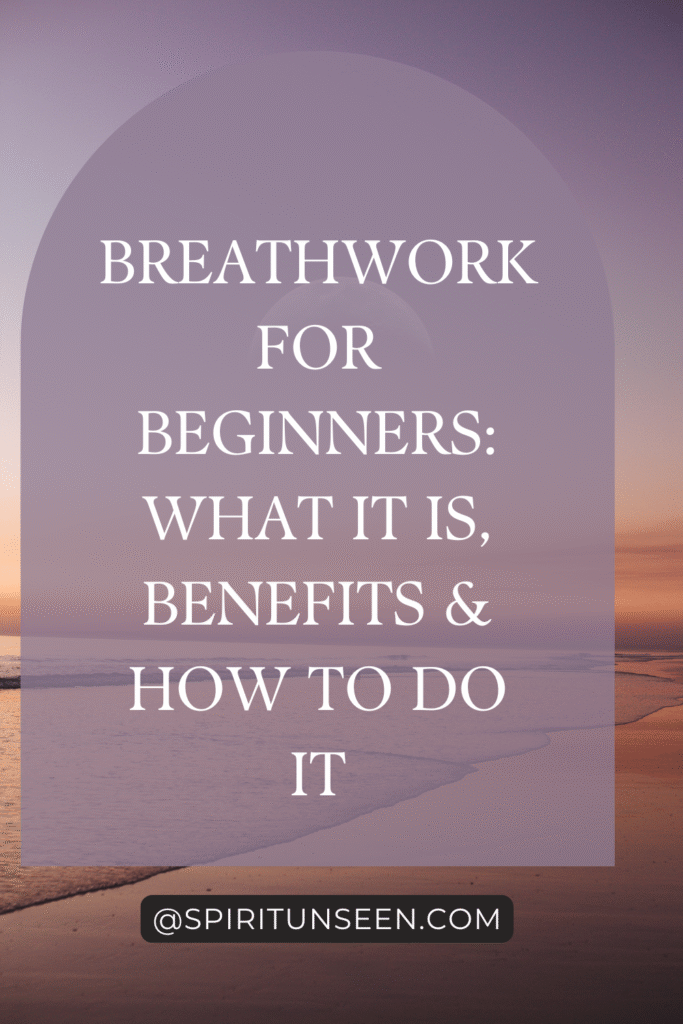
Introduction to Breathwork
Breathing is something we do automatically, often without thinking, but it is also one of the most powerful tools we have for improving our mental, emotional, and physical well-being. The practice of breathwork—using intentional, controlled breathing—has become increasingly recognized for its ability to reduce stress, improve focus, and promote overall health. With origins in ancient traditions, breathwork is a practice that’s accessible to anyone and easy to integrate into daily life.
This guide will take you through everything you need to know about breathwork, from its history and benefits to step-by-step instructions for beginners. By the end, you’ll understand how to use breathwork to enhance your well-being and handle life’s challenges more effectively.
What This Guide Covers:
- The definition and history of breathwork
- The mental, physical, and emotional benefits of conscious breathing
- Detailed instructions on various beginner-friendly techniques
- Frequently asked questions about breathwork
- A conclusion highlighting the importance of breathwork in daily life
Whether you’re new to breathwork or curious to learn more, this comprehensive guide will equip you with the knowledge and tools to get started.
What Is Breathwork?
Definition of Breathwork
Understanding the Concept of Breathwork
At its core, breathwork is the practice of controlling your breathing patterns to achieve specific goals. Unlike the involuntary breathing that keeps us alive, breathwork involves deep, conscious, and rhythmic breathing. This controlled focus on breath can help regulate emotions, improve mental clarity, and elevate physical health.
Breathwork falls under the umbrella of holistic practices and can be used alongside other forms like yoga, meditation, and mindfulness to deepen self-awareness and healing.
A Brief History of Breathwork
The roots of breathwork can be traced back thousands of years to ancient Indian, Chinese, and Tibetan practices. Pranayama, a foundational approach in yoga, is one of the earliest examples of breathwork. This practice emphasizes controlling the breath as a way to achieve balance and spiritual enlightenment.
Over the years, other cultures incorporated their own variations of breath control. The Taoist breathing techniques of ancient China focused on improving health and encouraging harmony, while Tibetan monks used breathing as part of their meditation practices.
Modern breathwork gained popularity in the West in the 20th century with the emergence of techniques like Holotropic Breathwork and Rebirthing Breathwork, which focus on emotional release and deep personal insight.

A Brief History of Breathwork
The origins of breathwork date back thousands of years and span multiple cultures. Here’s a quick look at its evolution:
- Pranayama in Ancient India:
One of the earliest forms of breathwork is Pranayama, a yoga practice that emphasizes breath control to balance the mind, body, and spirit. The term comes from Sanskrit, meaning “extension of breath” or “control of life force.” Practices like alternate nostril breathing stem from this tradition.
- Taoist Breathwork in China:
Ancient Taoist monks in China developed breathing techniques designed to promote health, balance energy, and support longevity. These practices later shaped modern concepts of Qi Gong and Tai Chi.
- Breathing for Meditation in Tibet:
Tibetan monks incorporated breathwork into their meditation rituals, using it to calm the mind and facilitate spiritual experiences.
- Modern Developments in the West:
Breathwork as a therapeutic tool took off in the West in the 20th century. Techniques like Holotropic Breathwork (developed by Stanislav Grof) and Rebirthing Breathwork (invented by Leonard Orr) were popularized for promoting emotional release and self-healing.
This blend of ancient wisdom and modern science makes breathwork a versatile and widely respected wellness practice today.
Benefits of Breathwork
Breathwork offers a wide range of benefits that target the mind, body, and emotions. Here’s how it can help you:
Benefits of Breathwork
Breathwork can transform your overall health and happiness. It provides benefits that bridge the mind, body, and emotions. Here’s how breathwork can make a difference:
Physical Benefits
- Reduces Stress and Cortisol Levels:
Conscious breathing activates the parasympathetic nervous system, your body’s “rest and digest” mode, which counteracts stress and reduces cortisol, the hormone linked to long-term health problems like heart disease.
- Improves Respiratory Function:
Deep breathing strengthens the lungs, making them more efficient. This can be especially beneficial for individuals with conditions like asthma or chronic obstructive pulmonary disease (COPD).omote better sleep patterns, making it easier to fall asleep and stay asleep.
- Strengthens Immunity:
Adequate oxygen delivery through proper breathing energizes cells and supports essential functions of the immune system.
- Enhances Vitality:
With better oxygenation and energy flow, you’ll experience increased vitality and resilience for your daily activities.
- Improves Heart Health:
Regular practice lowers blood pressure and can improve cardiovascular function by promoting relaxation and reducing the strain on your heart.
Slow, mindful breathing can help regulate emotions and decrease symptoms of anxiety.
Mental Benefits
- Enhances Focus and Cognitive Clarity:
Your brain depends on adequate oxygen to function at its peak. Structured breathing techniques provide that clarity and improve your ability to focus.
- Reduces Symptoms of Anxiety and Depression:
Slow diaphragmatic breathing calms the amygdala—the brain’s emotional center—helping to reduce fear and anxiety.
- Boosts Overall Mental Health:
Regular breathwork has been shown to increase emotional resilience, helping you stay afloat during challenging times and prevent burnout.
Regular practice teaches you to remain calm under pressure, increasing your ability to handle stressful situations.
How to Practice Breathwork (Step-by-Step Guide for Beginners)
If you’ve never tried breathwork before, don’t worry—it’s simple to get started. Here’s how you can begin:
Step 1: Find a Comfortable Space
Choose a quiet environment where you won’t be interrupted. Sit or lie down in a position that’s comfortable for you.
Step 2: Set an Intention
Before you start, determine what you want to achieve. Are you looking to relax, energize, or clear your mind? Your intention will guide the practice.
Step 3: Start with Simple Breaths
Take a deep inhale through your nose for 4 seconds, hold your breath for 4 seconds, and then exhale gently through your mouth for 6 seconds. Repeat this cycle for 2-3 minutes.
Step 4: Focus on Your Breath
Place your hands on your belly and focus on how it rises and falls with each breath. Pay attention to how the air feels entering and exiting your body.
Step 5: Gradually Increase Practice Time
Start with 5-minute sessions and increase gradually as you become more comfortable. Over time, extend to 15 or 20 minutes per session.
Step 6: Reflect Post-Practice
When you finish, take a moment to notice any changes in how you feel. This reflection will deepen your understanding of breathwork’s effects on your body and mind.
Popular Breathwork Techniques
Here are some widely used breathwork techniques that are beginner-friendly:
- Box Breathing
This involves inhaling for 4 seconds, holding your breath for 4 seconds, exhaling for 4 seconds, and holding again for 4 seconds. Repeat for several cycles to calm the mind.
- Alternate Nostril Breathing
Using your thumb and ring finger, close one nostril while inhaling and switch nostrils for the exhale. This technique balances energy and reduces stress.
- 4-7-8 Breathing
Take a deep breath in for 4 seconds, hold it for 7 seconds, and exhale fully for 8 seconds. It’s effective for calming anxiety and promoting relaxation.
- Diaphragmatic Breathing
Focus on breathing deeply into your diaphragm, allowing your belly to rise and expand. This practice encourages full oxygen exchange for better energy and calm.
- Lion’s Breath
Take a deep breath in through your nose, then exhale forcefully while sticking your tongue out and making a roaring sound. It’s both energizing and fun!
Tips for Beginners
- Be Consistent: Make breathwork a daily habit, even if it’s just 5 minutes a day.
- Start Small: Don’t overwhelm yourself with long sessions at the beginning.
- Use Guided Sessions: Apps and online videos can help guide you until you’re comfortable practicing on your own.
- Stay Hydrated: Drink water before and after each session to stay refreshed.
- Listen to Your Body: If you feel lightheaded or uncomfortable, stop and try again later.
Precautions and Contraindications
Although breathwork is generally safe, there are a few precautions to consider:
- Avoid Overdoing It: Intense breathwork can sometimes lead to dizziness or hyperventilation, so take it slow.
- Consult a Professional: If you have a medical condition, consult a doctor or therapist before trying advanced techniques.
- Pregnancy Caution: Pregnant women should stick to gentle, slow breathing exercises.
- Practice in a Safe Place: Especially for emotional release techniques, ensure you’re in a comfortable and supportive environment.
Conclusion
Breathwork is a versatile and accessible practice that can benefit individuals of all ages and lifestyles. By focusing on controlled breathing techniques, it helps to reduce stress, improve mental clarity, and enhance physical well-being. Studies have shown that incorporating breathwork into your daily routine can lower blood pressure, increase lung capacity, and even boost immune function. Whether you’re looking to manage anxiety or simply improve your overall health, breathwork offers a simple yet powerful tool that can be tailored to your personal needs.
FAQs About Breathwork
What is the best time of day to practice breathwork?
Morning is great for energizing techniques, while the evening is better for calming exercises.
Can anyone do breathwork?
Yes! However, people with specific medical conditions should consult a physician first.
Do I need any special equipment for breathwork?
No equipment is necessary; just a quiet space and comfortable position.
How long should a beginner practice breathwork daily?
Start with 5–10 minutes a day and gradually increase to 20 minutes over time.
Can I combine breathwork with other wellness practices?
Absolutely. Combining it with yoga, meditation, or mindfulness can enhance your results.
